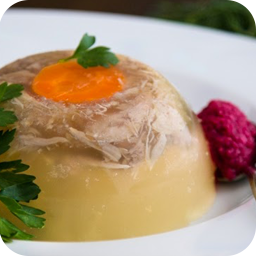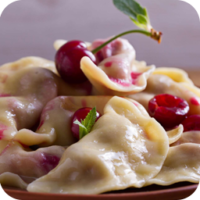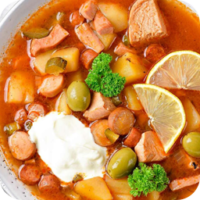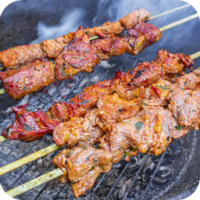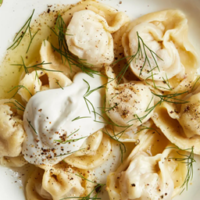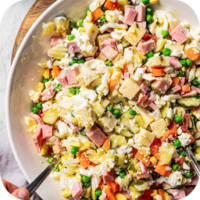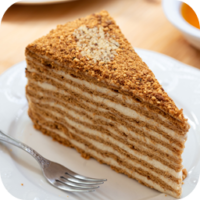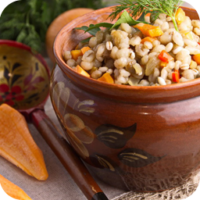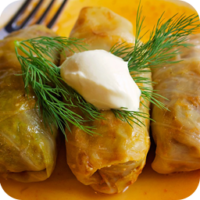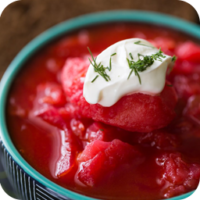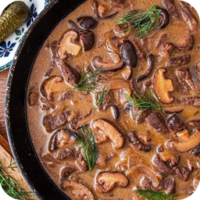Kholodets (холодец) is a traditional Russian dish made from meat, typically pork or beef, that is boiled for a long time to create a rich, gelatinous, savory aspic or meat jelly. The dish is served cold and is often found on the table during holidays and celebrations in Russia, especially during New Year’s Eve, Christmas, and Easter.
Key Ingredients:
- Meat:
- The main ingredient in Kholodets is pork, beef, or sometimes chicken. The meat is usually boiled with bones to create a rich broth. Pork legs or beef shank are often used because of their natural gelatin, which helps the dish set into a jelly-like consistency.
- Water:
- Water is used to boil the meat and create the broth. The longer the meat is boiled, the more gelatin is extracted, which helps the Kholodets solidify once it cools.
- Vegetables and Aromatics:
- Common additions include onions, garlic, carrots, bay leaves, peppercorns, and other spices to enhance the flavor of the broth.
- Gelatin:
- While traditional Kholodets relies on the natural gelatin from meat and bones, some recipes may add extra gelatin to ensure the dish sets properly.
- Garlic and Mustard:
- Once the Kholodets is ready to serve, it is often garnished with minced garlic and served with mustard or horseradish on the side for added flavor.
Flavor Profile:
- Kholodets has a rich, savory flavor, with the broth having a deep meaty taste, complemented by the natural sweetness of the onions and carrots. The gelatinous texture gives the dish a satisfying, smooth mouthfeel, while garlic and mustard provide a spicy kick when served.
How It’s Made:
- Prepare the Meat:
- The meat (pork, beef, or chicken) is cut into pieces and boiled in water with onions, garlic, carrots, bay leaves, and peppercorns for several hours (usually 3-5 hours) until the meat is tender and the broth is rich and flavorful.
- Strain the Broth:
- After boiling, the meat and vegetables are removed, and the broth is strained to remove any impurities, bones, or solid pieces.
- Set the Aspic:
- The strained broth is poured into a large dish or individual molds, and the cooked meat is shredded or chopped and added back into the broth. If necessary, extra gelatin can be added to ensure the dish sets properly.
- Cool and Refrigerate:
- The dish is left to cool at room temperature and then placed in the refrigerator to set for several hours or overnight. The broth solidifies, and the dish takes on a jelly-like consistency.
- Serve:
- Kholodets is typically served cold as an appetizer or side dish, often garnished with garlic and mustard for extra flavor.
Cultural Significance:
- Kholodets is a traditional dish in Russian cuisine, commonly made for special occasions, family gatherings, and holidays. It is particularly popular during the winter months when hearty and comforting dishes are favored.
- It is considered a hearty and satisfying dish, often served with vodka or other spirits during festive occasions.
- The dish is also common in other Eastern European countries, such as Ukraine, Belarus, and Poland, where it is enjoyed in similar forms.
Health Benefits:
- Rich in collagen: Kholodets is a good source of collagen from the gelatin in the meat, which is beneficial for joint health, skin elasticity, and digestive health.
- Protein-packed: The dish provides a good amount of protein from the meat, which is essential for muscle growth and repair.
- Low in carbohydrates: Kholodets is relatively low in carbs, making it suitable for those following low-carb or keto diets.
Variations:
- Kholodets with Vegetables:
- Some recipes include additional vegetables like potatoes or green peas to make the dish more substantial and colorful.
- Kholodets with Different Meats:
- While pork and beef are most common, some versions of Kholodets use poultry, such as chicken or duck, for a lighter version of the dish.
- Kholodets with Spices:
- In some regions, Kholodets is flavored with additional spices such as allspice, cloves, or dill to add variety to the flavor profile.
Serving Tips:
- Kholodets is typically served cold, cut into squares or slices, and accompanied by mustard, horseradish, or vinegar for added spice.
- It pairs well with rye bread or pumpernickel bread, often enjoyed as part of a Russian appetizer spread.
- The dish is also commonly served with a glass of vodka or kvass during celebrations.

